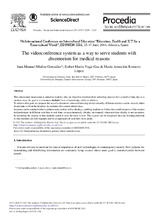Mostrar el registro sencillo del ítem
The videoconference system as a way to serve students with absenteeism for medical reasons
| dc.contributor.author | Muñoz González, Juan Manuel | |
| dc.contributor.author | Vega Gea, Esther María | |
| dc.contributor.author | Romero López, Asunción | |
| dc.date.accessioned | 2019-02-04T12:03:00Z | |
| dc.date.available | 2019-02-04T12:03:00Z | |
| dc.date.issued | 2017 | |
| dc.identifier.uri | http://hdl.handle.net/10396/17759 | |
| dc.description.abstract | This educational innovation is aimed at students who are forced to interrupt their schooling process for a period of time due to a medical issue. Its goal is to minimize students’ loss of knowledge, skills or abilities. To achieve this goal, we propose the use of a classroom videoconferencing device whereby different sessions can be viewed, either from home or from the hospital, by students who cannot attend class. Sessions can be watched either synchronously (online or live display), enabling students to follow the overall progress of the sesión and participate in different activities in real time; or asynchronously (display on demand) when real-time display is not an option, by recording the session so that students watch it once the class is over. This system can be integrated into any learning platform so that students can self-organize and do assignments all activities more easily. | es_ES |
| dc.format.mimetype | application/pdf | es_ES |
| dc.language.iso | eng | es_ES |
| dc.publisher | Elsevier | es_ES |
| dc.rights | https://creativecommons.org/licenses/by-nc-nd/4.0/ | es_ES |
| dc.source | Procedia - Social and Behavioral Sciences 237, 1229-1235 (2017) | es_ES |
| dc.subject | Videoconference | es_ES |
| dc.subject | Absenteeism | es_ES |
| dc.subject | Primary school | es_ES |
| dc.subject | Medical causes | es_ES |
| dc.title | The videoconference system as a way to serve students with absenteeism for medical reasons | es_ES |
| dc.type | info:eu-repo/semantics/article | es_ES |
| dc.relation.publisherversion | https://doi.org/10.1016/j.sbspro.2017.02.194 | es_ES |
| dc.rights.accessRights | info:eu-repo/semantics/openAccess | es_ES |

